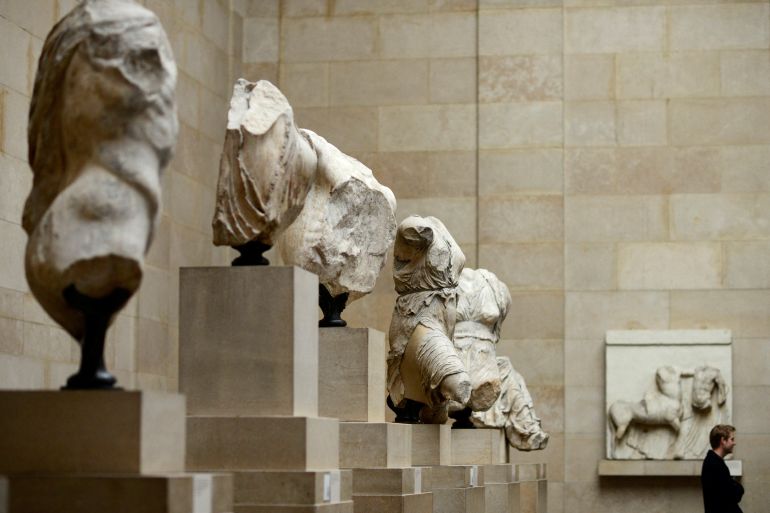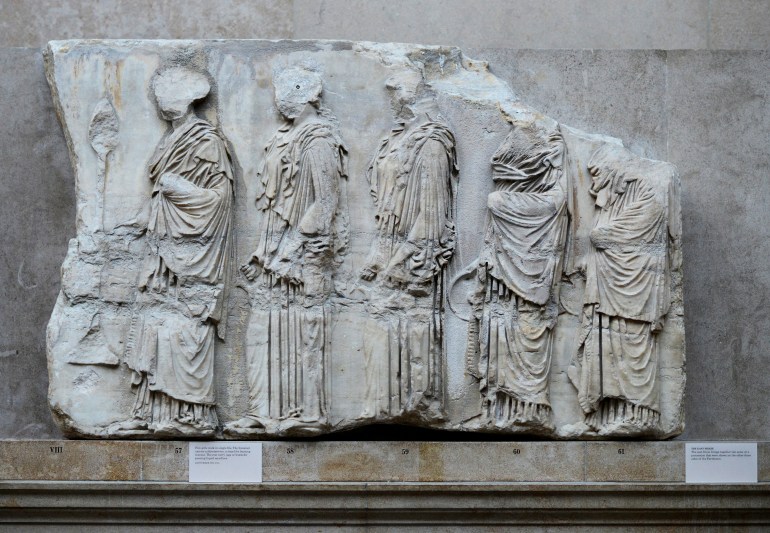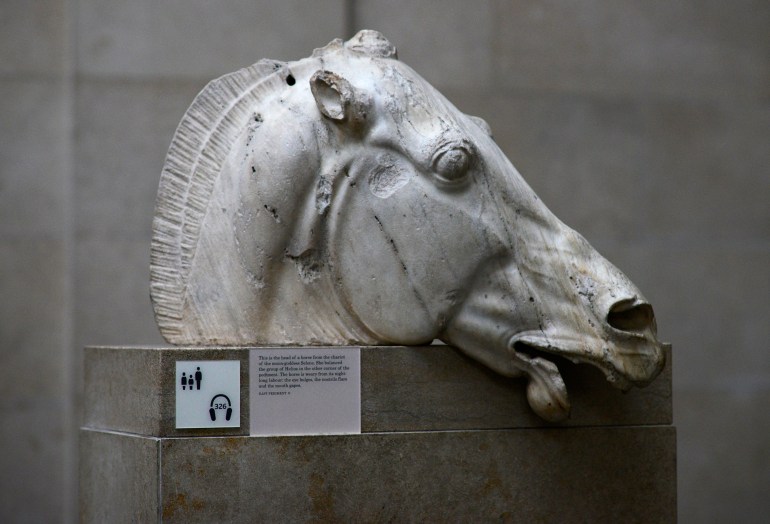Rumours of Parthenon Marbles’ return ‘overhyped’, experts say
Greece and the British Museum are in talks about the possible repatriation of the Parthenon Marbles in London to Athens.

Athens, Greece – A trustee of the British Museum has confirmed the institution is in talks with the Greek government about the disposition of the Parthenon Marbles, but has told Al Jazeera that a deal may be elusive.
“There is certainly movement, but it is being overhyped,” said Mary Beard, professor of classics at Cambridge University and a trustee since 2020.
Keep reading
list of 4 itemsGermany returns 20 Benin bronzes to Nigeria, noting ‘dark past’
Egypt repatriates looted ancient Green Coffin sarcophagus from US
‘Act of plunder’: Egyptians want the Rosetta Stone back
“I think something is really happening … There have been discussions between [board of trustees chair George] Osborne and [Greek premier Kyriakos] Mitsotakis,” she told Al Jazeera.
The Marbles are architectural sculptures removed from the Acropolis of Athens in 1801 by Lord Elgin, when Greece was an Ottoman dominion, and displayed at the British Museum since 1817.
Greece says they form inseparable parts of the monument and must be returned.
“There is real desire to do something. After 200 years, surely we can get somewhere better than where we are,” Beard said. “Is the problem going to be resolved? I’m not sure.”
There was excitement last July, when the British Museum told the Sunday Times it was offering to talk to Greece about a “deal” over the Marbles.
“The British Museum opted to come out and say they were talking [with us] and trying to find a solution,” said Eleni Korka, honorary general director of antiquities and cultural heritage at the Greek culture ministry and key negotiator since Greece made public its quest to bring back the Marbles in 1981.
“This sort of public statement has never happened before. It’s only in the last year. Have they changed policy? Have they been forced to?” Korka told Al Jazeera.

But a British Museum statement last November dashed hopes of a quick deal.
“We operate within the law and we’re not going to dismantle our great collection,” a spokesperson said – a reference to a 1963 law that forbids the British Museum to divest itself of any part of its collection.
The British Museum has offered to loan the sculptures to the Acropolis Museum in Athens, built in 2009 to house them.
Greece refuses to make a loan request because it would imply British Museum ownership, and Greece insists on an outright return.
But Prime Minister Kyriakos Mitsotakis, who faces an election this year, has been gently raising hopes.
Last month he told students at the London School of Economics there was progress and “a sense of momentum”.
In early January, British Museum sources told the media there were “constructive discussions” with Greece over the Marbles’ return.
Mitsotakis told Greece’s president his government had made “very systematic, quiet” efforts to repatriate the Marbles.
But Michelle Donelan, the culture minister of the United Kingdom, again dashed hopes, telling BBC Radio 4 that the sculptures “belong here in the UK”.
Greek Culture Minister Lina Mendoni called ongoing negotiations “difficult but not impossible”.
Asked if Greece would consider a loan, she said the country was sticking to its red lines.
“The fact that the [Greek] prime minister and culture minister clarified there cannot be progress without the ownership issue being cleared up, means it’s not going well,” said Korka.
Controversial from the start
Elgin’s removal of the sculptures was controversial from the outset.
Britain’s House of Lords debated in 1816 whether he had really secured permission from the Ottoman government, which then held dominion over Greece.
Elgin himself implied the Marbles were improperly removed, because the Lords’ main concern was whether he had used his influence as imperial ambassador to Constantinople to extract a permit that benefitted him personally.
“Did the permission specifically refer to the removing of statues, or was that left to discretion?” the committee of inquiry asks.
Elgin replies: “No, it was executed by the means of those general permissions granted; in point of fact, permission issuing from the Porte for any of the distant provinces, is little more than an authority to make the best bargain you can with the local authorities.”
Elgin’s fellow philhellene, Lord Byron, lamented the Marbles’ removal and excoriated Elgin in The Curse of Minerva: “So let him stand, thro’ ages yet unborn, / Fixed statue on the pedestal of scorn!”
The British Museum claims Elgin “was granted a permit” to “draw, measure and remove figures”. But critics say he stretched that to remove far more than was intended.
“Among the bribes Elgin is known to have given is 100 pounds to the Kaimacam [district governor] in Constantinople to release the second shipment [of Marbles], and an amount to the Disdar [fortress commander] in Athens equal to 35 times his annual salary. Elgin documented all expenditures because he was financed by his in-laws,” said Korka.

The British people seem to have moved in favour of restitution.
An Economist survey in 2000 found that two-thirds of British MPs would vote for the Marbles’ return if a motion were tabled.
A Sunday Times survey last August found that 78 percent of Britons would return the Marbles, and a poll this month by the Evening Standard found a clear majority of 53 percent of Britons favouring their return – more than the majority that voted for Brexit.
“There’s a very important change in the UK in public opinion and individuals who have an opinion on the matter, from the entire political spectrum, who now openly argue in favour of the marbles’ reunification, recognising their uniqueness,” said Mitsotakis.
But Elgin is not entirely reviled, even in Greece.
“It’s true that [the Marbles’] removal saved them from exposure to war and destruction,” says the world’s ranking Acropolis archaeologist, Manolis Korres, who has dedicated half a century to studying and restoring the Parthenon and other buildings there.
Turkish occupiers burned a six-storey marble column from the Temple of Zeus to make ash, a component in the concrete used to build the mosque in Monastiraki in 1758. A similar fate befell a neighbouring temple to the river god Ilissos 20 years later.
The Greeks also caused damage. “There are other monuments that were utterly pulverised in the Greek War of Independence,” says Korres. “The Monument of Thrasyllos got blown up in 1827, the last year of the revolution. It was blown to smithereens. Elgin had taken the statue of Dionysos from it, and it is now in the British Museum and was thus saved.”
But Korres agrees the Marbles must now return.
“Their possession by another museum is not morally supportable. The question of legality is moot; 200 years ago slavery was legal, too.”
The British Museum is displaying “a parochial, phobic, colonial attitude” that cannot last, Korka said.
“If at the beginning of this process I believed the marbles would return 100 percent, I now believe it 1,000 percent … The question is when.”